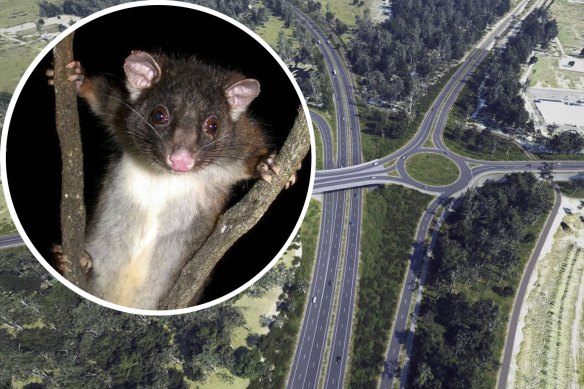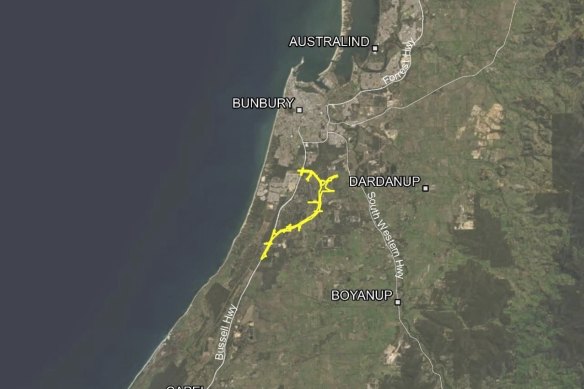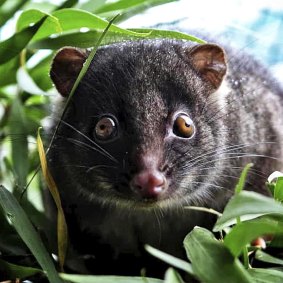This was published 2 years ago
Critically endangered possums to lose home to $1 billion WA road
Seventy-two critically endangered western ringtail possums in the state’s South West will be ‘displaced’ for a $1 billion road, with the parks authority unable to guarantee their survival.
The Bunbury Outer Ring Road is under construction, but after community outcry and an appeals process, Western Australia’s Environment Minister has flagged the consideration of alternative routes for the yet-to-be-approved southern section.

Seventy-two western ringtail possums could be displaced by the construction of the Bunbury Outer Ring Road.
Ascertaining the exact size of the remaining population of the federally protected species is difficult, but a 2018 estimate suggested there could be less than 3500 left in WA which prompted a reclassification of the marsupial from vulnerable to critically endangered.
Endangered black cockatoo habitat and ecological communities of banksia woodlands and tuart trees will also be felled in 71.5 hectares of clearing for the southern section of the 27-kilometre project, first proposed in the 1970s.
Carnaby’s and forest red-tailed black cockatoos and the western ringtail possum are all on the federal government’s national list of 100 priority species.
The road would bypass Bunbury, WA’s second largest city, separating regional tourists and freight activity from local traffic. Travellers would save about 15 minutes going back and forth from the Perth and Margaret River regions.

A map of the proposed Bunbury Outer Ring Road.Credit: Main Roads WA
An Infrastructure Australia review in 2020 concluded the project’s benefits marginally outweighed its total costs, although this was before the cost blew out by about $150 million earlier this year as construction projects felt the bite of a global logistics and materials crunch.
The state’s Environmental Protection Authority recommended late last year the road – which cuts through the Gelorup area, south-east of Bunbury, mostly made up of residential bush blocks – could proceed if Main Roads WA provided offsets to the habitat destruction.
This included the purchase of 170 hectares of existing habitat and the rehabilitation of 220 hectares of land elsewhere as suitable possum and cockatoo habitat, fox baiting and the installation of animal bridges over the road.

Injured western ringtail possums in the South West often find their way to refuges like FAWNA in Busselton. Credit: Friends of Gelorup Corridor
The 72 possums surveyed in the Gelorup area would be ‘shepherded’ to neighbouring bushland during the clearing process, not ‘translocated’ (physically trapped and moved), as translocation often results in the animals.
Advice from the Department of Biodiversity, Conservation and Attractions to the EPA over 2021 said it would be difficult to ascertain whether the Gelorup possum population would survive.
It advised in emailed correspondence that the proposal was likely to have a significant impact on the Gelorup population and potentially on the greater southern Swan Coastal Plain population.
It was hard to say there would be no deaths if the possums were shepherded into the territories of other populations, as there would be territorial conflicts and competition for food.
A monitoring program has been proposed to determine the mortality rate.
The DBCA concluded the overall recovery of the species would not be impacted by the loss of possum habitat and individual animals. The authority also noted there was a declining availability for remnant vegetation with good possum habitat suitable for acquisition in the Bunbury to Dunsborough area for use as a project offset.
Appeals convenor calls for more offsets
The community has railed against the EPA decision, lodging 170 appeals.
This week the appeal convenor decided not to send the project back to the EPA for another review but acknowledged community concerns and upped the requirement for land offsets for cockatoos, tuart and banksia if the southern section went ahead.
Friends of the Gelorup Corridor acting chairman Sue Chapman said West Australians deserved better.
“Main Roads had the potential to avoid a large amount of the environmental damage. They had the opportunity to plan a better road and they have taken a short-term easy option,” Dr Chapman said.
“I’m really grateful the appeals convenor has said to Main Roads ‘you haven’t done enough offsets.’ But the issue of revegetation is completely inadequate.
“We’ve been given this extraordinary amount of money with very little strings attached. But there has been no independent cost-analysis of this road at any point.”
Expected habitat loss to Bunbury Outer Ring Road southern section
- 60.9 hectares of black cockatoo habitat
- 1088 black cockatoo trees with potential nesting hollows
- 11 black cockatoo trees with suitable nesting hollows
- 39.2 hectares of south-westernbrush-tailed phascogale habitat
- 23.4 hectares of vegetation representative of the Banksia woodlands of the Swan Coastal Plain Priority Ecological Community
- 4.4 hectares of vegetation representative of both Tuart woodlands and forests of the Swan Coastal Plain ecological community
- 4.5 hectares of vegetation representative of the Southern Swan Coastal Plain
Environment Minister Reece Whitby agreed with the convenor about the offsets to put in place if the southern section proceeded but also stated the ongong state decision-making process would consider the merits of alternative options.
“The acceptability of this proposal in the context of its environmental risks and other matters such as social and economic considerations will be taken into account,” he wrote.
Conservation Council of WA executive director Maggie Wood said the determination on the appeal stopped short of any meaningful decisions to prevent significant environmental harm.
“Other more viable and less damaging routes for the ring road are available,” she said.
“Appeals lodged against this project shows how poorly it has been received ... There has been a distinct lack of strategic planning from Main Roads and environmental concerns appear to have taken a back seat.
“We would urge the WA Government to seriously consider an alternative route.”
No final decision has been made by the state government on the southern section of the road but the project also requires a federal environmental approval to go forward.